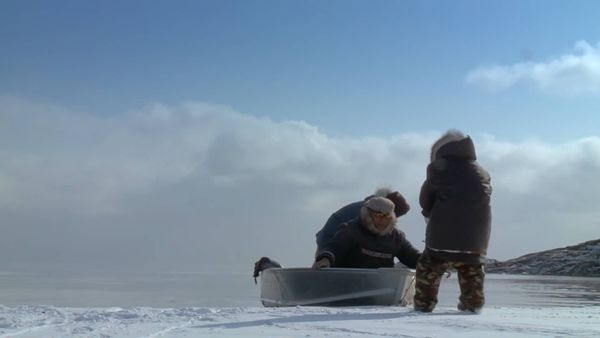Eye For Film >> Movies >> Angry Inuk (2016) Film Review
Angry Inuk
Reviewed by: Jennie Kermode

What does it mean for an Inuit person to be angry? As in most cultures that have developed in harsh environments, where having to leave a shelter could be deadly, the Inuit strongly reject interpersonal aggression. They have alternative ways of resolving conflict. But when a culture like this meets a more aggressive one, it's all too easy for them to find themselves exploited or have their concerns overridden. This film is an attempt by an Inuit filmmaker to fight back against such treatment, taking on a highly emotive subject and challenging what to many viewers will seem like the only right way to approach it.
Have you ever worn fur? Not artificial fur but the kind that used to be wrapped around many a Hollywood starlet - fur taken from seals? The majority of people wince at the thought. Among meat eaters, leather is generally seen as acceptable because it's a by-product, but the idea of killing something just to use its skin is seen as barbaric. Thoughts turn to little harp seal pups, plump and fluffy, flopping around helplessly as they are approached by men with clubs. It's the result of very effective propaganda which demonised commercial hunting in one region of Canada. The trouble is that, as legislation followed and the market for such furs collapsed, so did the market for other seal products - skins from adult animals hunted for food - on which the Inuit survived. The exceptions that permit them to engage in subsistence hunting take no account of the fact that they need to sell skins and related products in order to make money, because their economic options are very limited and they do interact with the modern world.

Alethea Arnaquq-Baril, presenting as well as producing, paints a bleak portrait of the impact of pressures on the seal trade. Unable to sustain themselves in their traditional hunting grounds (a situation made more difficult by climate change), many Inuit have moved into towns. There, like Australian bushmen or Scottish fishermen facing similar problems, many end up dependent on welfare, losing hope for the future. The suicide rate has skyrocketed. Arnaquq-Baril doesn't mention the flight of the young to foreign cities or the restrictions on dog ownership that have led to dependence on expensive imported fuel, but there's arguably no need for additional detail - we can see that the people there are suffering.
Illustrating this is not as obvious as it might seem. There are numerous challenges involved in communicating between cultures. One woman fondly shows us a picture of small children with their hands and faces covered in blood. For her it represents a happy memory of their delight when their father brought home fresh seal meat. To many viewers elsewhere it will simply seem grotesque. There's humour in these moments, however unintentional, but not everyone will appreciate it.
Where the film gets really interesting is where Arnaquq-Baril tries to communicate with the animal rights organisations pushing for further anti-sealing legislation. Email goes unanswered, meetings are cancelled at the last minute; even protests are called off when it emerges that representatives of the Inuit are going to be there. Arnaquq-Baril makes some strong claims about their motives, arguing, amongst other things, that they know full well the harm they are doing to the Inuit but maintain their strategy because imperilled baby seals raise a lot of money they can spend on other things. This is weaker because there's no response from the other side, but she does find some testimony to substantiate it. What's missing, really, is any suggestion of practical solutions, though astute viewers will see several possibilities. A licensing system is mooted but obvious problems around regulation and marketing go unaddressed. But as a presentation of evidence for the defence of seal hunting, this is an impressive piece of work.
Reviewed on: 24 Jan 2017














